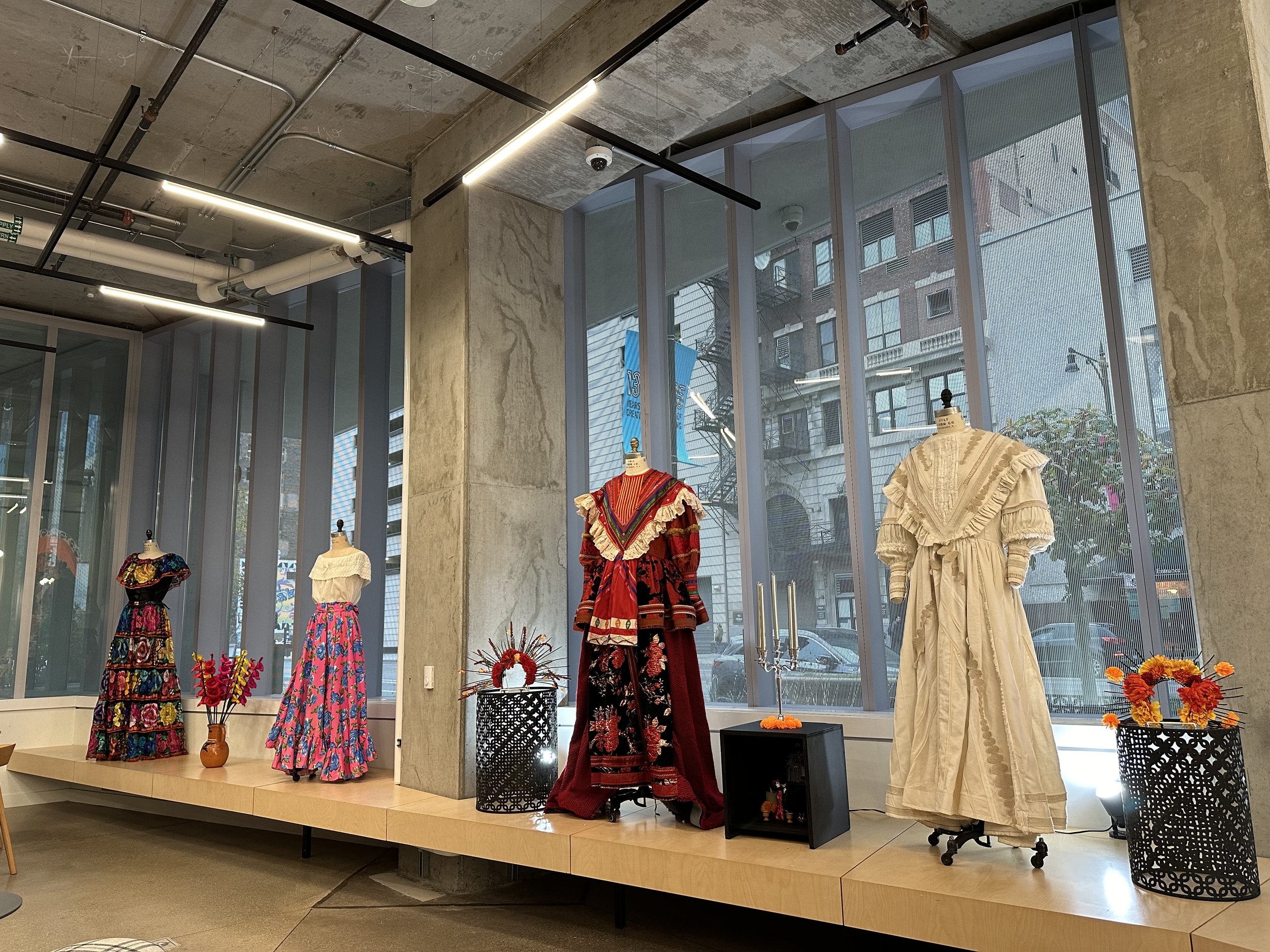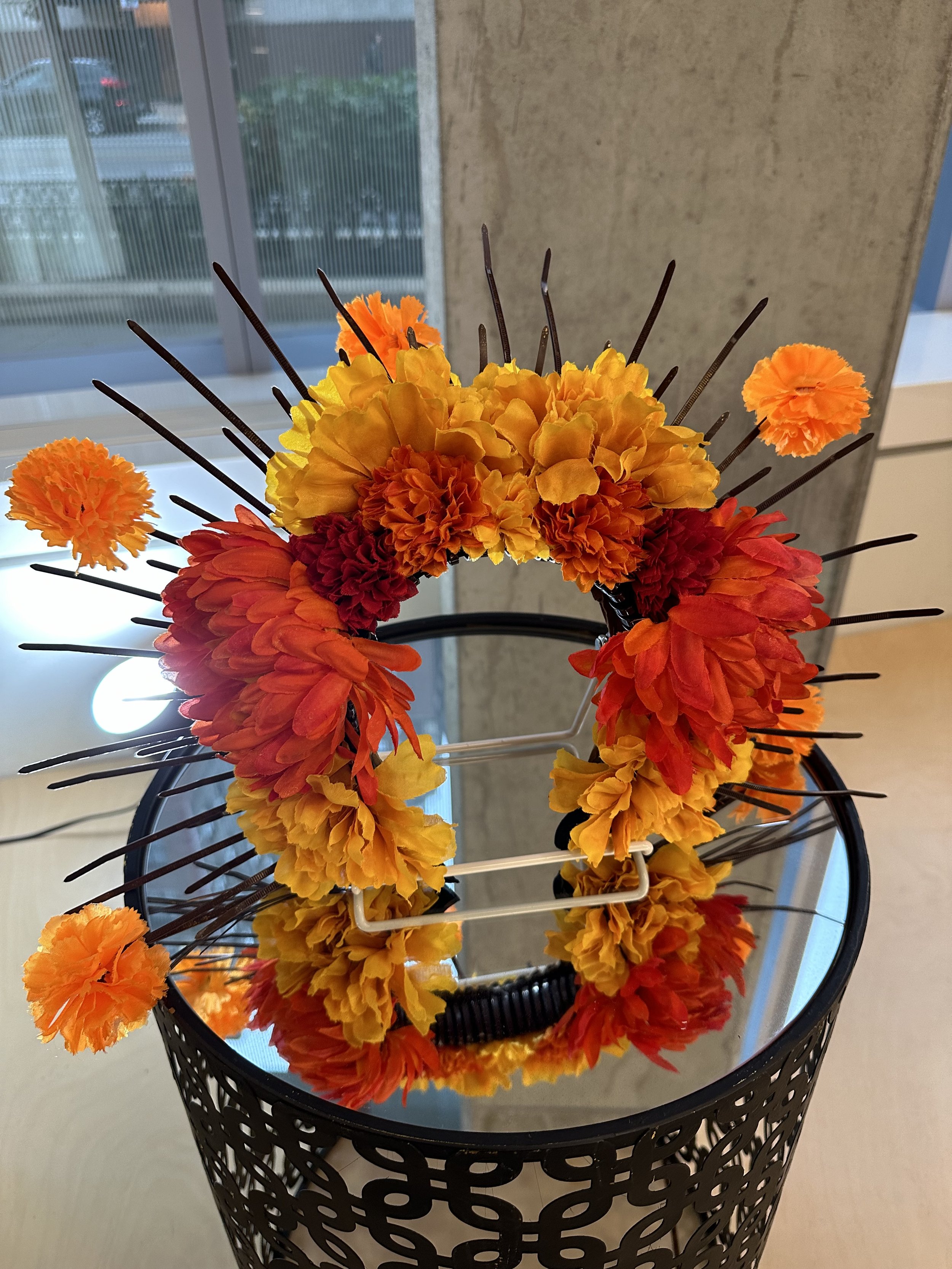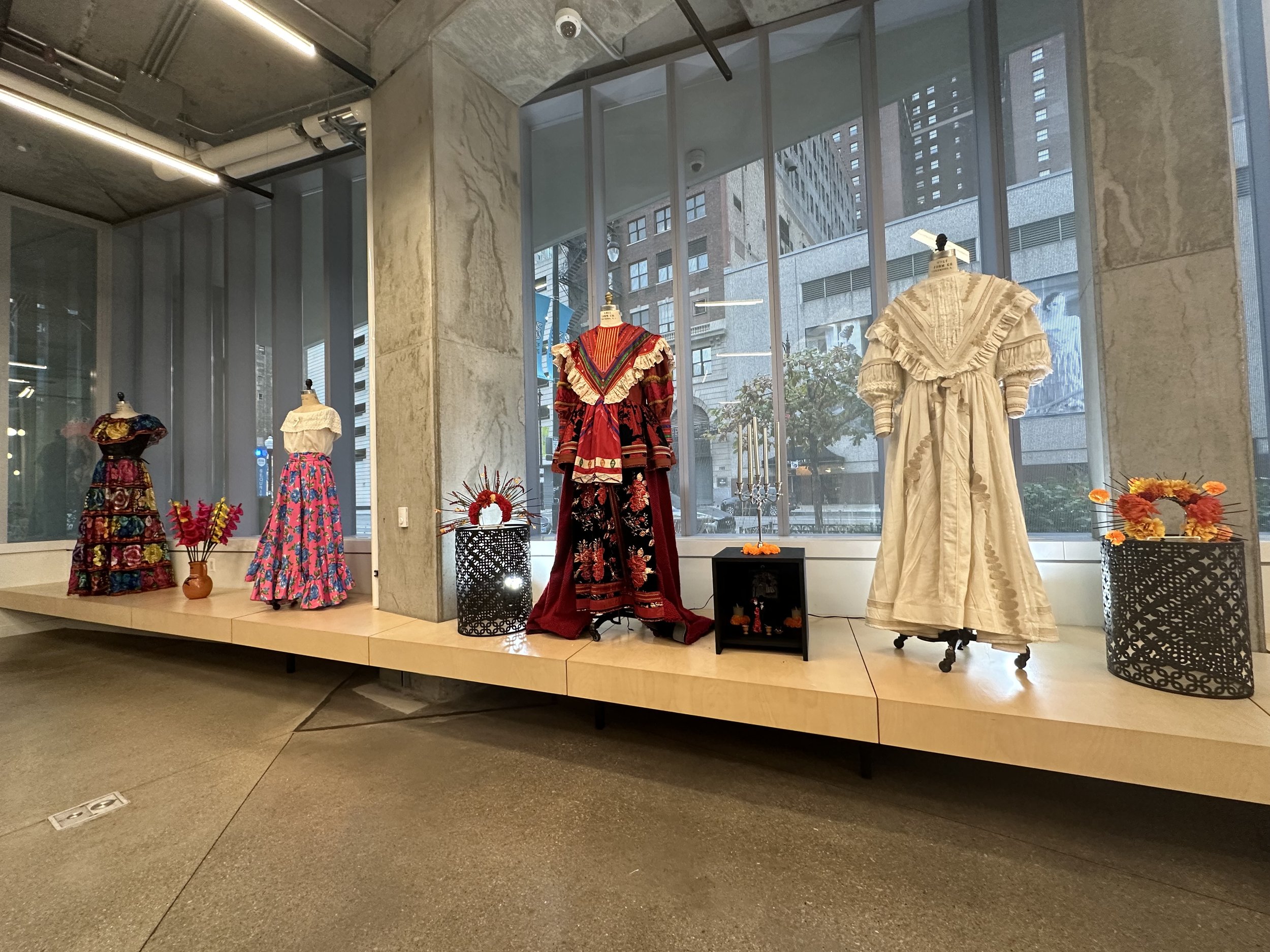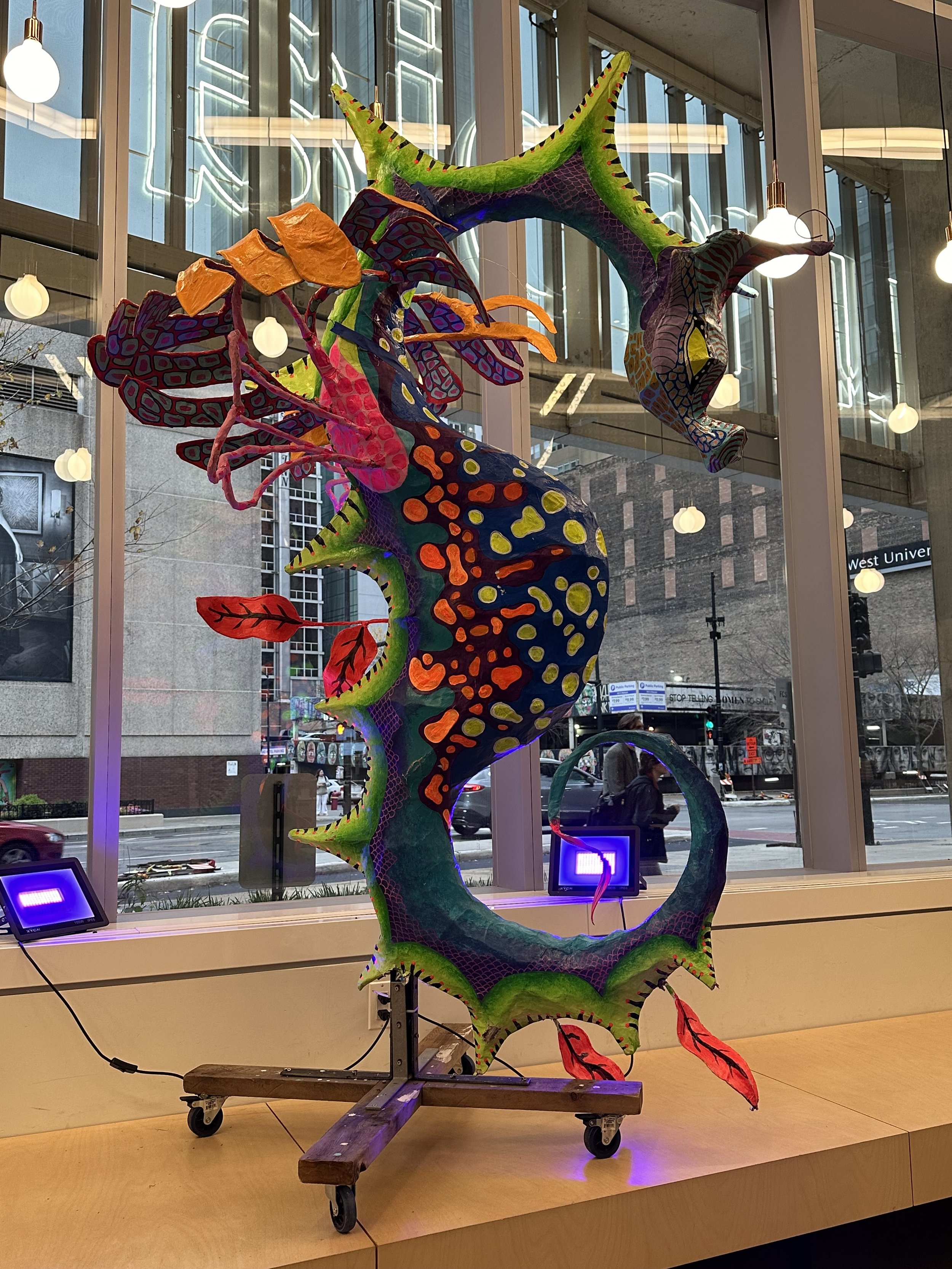
Day of the Dead
Día de Los Muertos is a beautiful tradition that recognizes the inevitable cycle of life and death, uniting us all.
At the entrance, we pay homage to the indigenous ancestors whose traditions have endured through generations. Two authentic danzante garments are displayed, showcasing vibrant colors and intricate beadwork that reflect the incredible artistic talents of our Mexican ancestors and remind us to feel pride in our roots.
As we move through the installation, we witness the evolving story of Mexico and the influence of Spanish culture. This fusion is highlighted by custom garments designed by Columbia alum Norma Espinoza, representing the blend of indigenous and European styles. One piece pays homage to La Catrina, the iconic figure originally created to critique the extravagant lifestyles of the elite in Mexico. Today, she embodies the Day of the Dead, inspired by José Guadalupe Posada's original etching. The undeniable syncretism of cultures is a hallmark of Mexican traditions.
At the heart of the installation, three vibrant community ofrendas celebrate the personal and communal elements of remembrance. Each altar invites indivi
The Gallery























Altars
Ofrendas consist of various personal and symbolic objects that vary by region, city, town, and household. A traditional ofrenda often honors Mesoamerican traditions by including items symbolizing the four elements—water, earth, fire, and air. While all ofrendas are unique, with no set rules about what should or should not be included, a few common items are typically found on most ofrendas.
Incense
Copal incense, historically burned in Mesoamerica, retains its significance in contemporary Day of the Dead ceremonies. Positioned near altars, it adds an aromatic element to attract spirits. The term "copal" derives from the Náhuatl word "copalli," meaning "incense." Harvested from the copal tree, it was used by the Aztecs and Mayans in rituals to the Gods. Placed in the altar, copal serves as an environmental purifier, facilitating the entry of spirits without risk.
Candles
Candles symbolize the element of fire and play a crucial role in lighting the soul’s path to its altar. White candles, representing purity, are commonly used, along with candles featuring a loved one’s chosen saint, reflecting Catholic influence.
Bread of the Dead
Pan de Muerto, is a sweet bread that is commonly placed on altars or consumed and dipped in a warm hot chocolate during this time. The bread symbolizes the cycle of life and death due to its circular shape.
Marigolds
Marigolds are utilized in altars and are often taken to the graves of loved ones. Marigolds are abundant during this period in Mexico, and their potent fragrance is believed to attract the spirits of departed loved ones, guiding them in their journey to the living. With a deep history, marigolds vibrant colors are said to symbolize the sun and foster a sense of joy and peace.
Perforated Paper
Papel Picado is colorful and delicate sheets of paper meant to symbolize the wind. They are adorned and cutout with designs like skeletons and animals. As loved ones arrive, the paper moves, alerting the host of their presence.
Water
Representing one of the four elements and the symbol of life, agua quenches the soul's thirst after its long journey to the living world.
Decorated with flowers and intricate designs, sugar skulls symbolize death, and the sweetness of life. Placed on altars, they may bear the name of the deceased, a tradition that some say dates to the Aztecs.
Sugar Skulls
Personal Objects and Food
Objects, ranging from clothing to favorite hobbies, define a loved one on the altar. These items, along with a soul's favorite foods, reflect the varied tastes and preferences of each ancestor, creating a sense of familiarity.
featured Artists
Gloria Contreras
Gloria is a local Mexican folk artist based in Chicago. With a deep passion for Mexican culture and traditions, she began her artistic journey by creating papier-mâché catrinas for Día de los Muertos, later incorporating the traditional Mexican craft of cartonería. Gloria has traveled to Mexico numerous times to study under master artisans, consistently returning with a wealth of inspiration and creativity. She invites you to enjoy this glimpse into her imagination
Altar and Alebrije
Norma Espinoza
Norma Espinoza is a Columbia College Chicago alumna with a BFA in Fashion Design, specializing in textile manipulation, embellishments, and Indigenous Mexican artistry. She focuses on sustainability by creating garments that blend Mexican and Indigenous aesthetics. Recognizing the lack of representation for non-Western designers in haute couture, Norma aims to become a recognized Indigenous Mexica couture designer, inspiring future Latinx youth to pursue careers in high-profile fields. She is dedicated to demonstrating how traditional slow fashion methods can thrive in the fast-paced fashion industry while highlighting often-overlooked aspects of Indigenous culture and traditions.
Mexican Folkloric Dresses: La Catrina and Lejania
Jose Luis Izalde Santiago
Danzante Garments
José Luis Izalde Santiago, also known as Don Pichi, was born in Tacuba, Mexico City. He is a founding member of the dance group Esplendor Azteca, established in 1972, which was one of the first pre-Hispanic dance ensembles to perform in Chicago, promoting the traditions of pre-Hispanic dance. Currently, Don Pichi specializes in designing and creating beautiful danzante garments. His artistic designs and efforts to preserve Mesoamerican dance traditions have been widely admired.
LEVI SECTER
Levi Secter is a film and television major at Columbia College Chicago, where he focuses primarily on film audio, postproduction, and location sound. For his soundscape project, Levi interviewed attendees of Día de Los Muertos celebrations and incorporated environmental elements such as children playing, various styles of mariachi music, church bells, and animal sounds. In his free time, he enjoys playing the banjo, watching movies, traveling, and attending music festivals. He also collaborates on student films at Columbia, working on set in postproduction and audio roles.
Día De Los Muertos Soundscape
